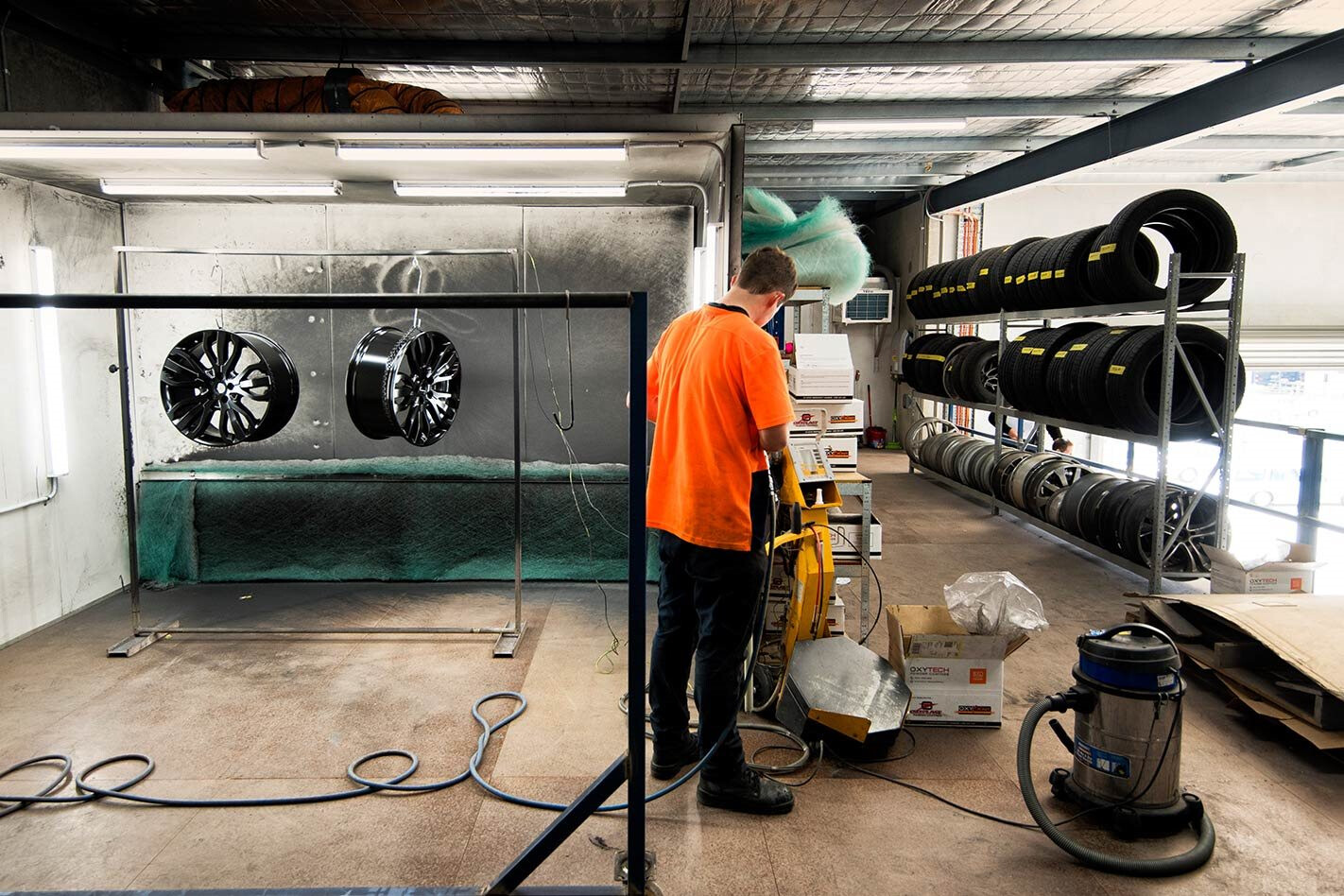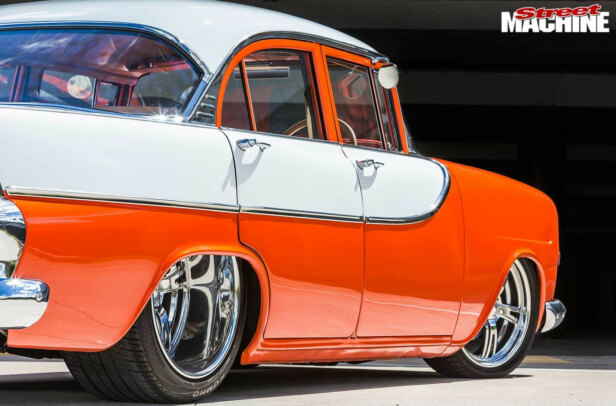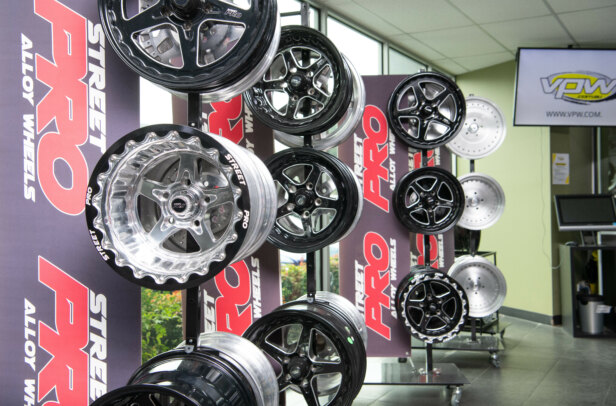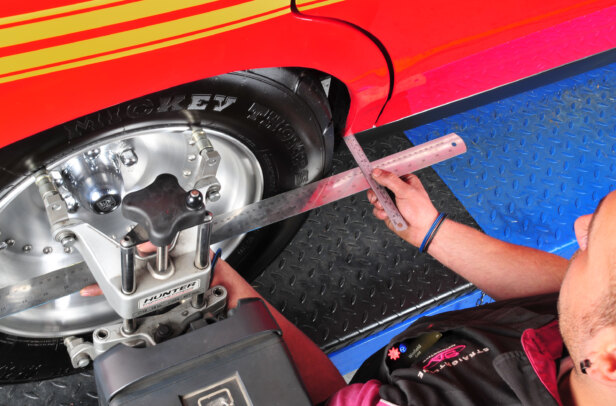WE’VE all done it – misjudged that parallel parking effort and kerbed the rim, or understeered into a ‘traffic calming’ device and bent a rim. Not a big deal if you’re running 14×6 steelies like myself, but if you’re rolling on some big-inch alloy wheels and have a bit of an incident, don’t despair; you might not have to throw them in the bin. Even very badly damaged rims can be repaired to as-new condition by the guys at Elite Wheel Services & Powdercoating in Forrestdale, WA.
EWS also handles car restorations – that’s why the ’57 is up on the hoist – but the late-model stuff makes up the bulk of the wheel repair business, and the dropoff service and three-day turnaround makes it easy for the customers
It’s a relatively new business set up by Gareth and Alison Lougher (whose 6APEAL Torana we featured in SM, Apr ’13) and Nigel Thomas. Gareth has been putting his skills as an expert fabricator and welder to good use and Nigel brings his skills as a machinist to the business. For more info, check them out at elitewheelservices.com.au or call them on (08) 9497 1616.
WHEEL DAMAGE:
1. The most common type of damage Elite Wheel Services sees are kerbed rims. If the damage is bad enough, material may need to be added with TIG welding; otherwise, a small amount of filler is used and the whole wheel colour-matched and repainted.
2a. This is pretty typical of the type of damage that can occur when you go over a kerb at high speed.
2b. It looks pretty terminal, but we’ll follow this wheel through the process of it being brought back to life.
WHEEL REPAIR STEP-BY-STEP:
1. The first step is to remove the tyre, which is handled in-house. It can be a pretty tricky job with low-profile tyres, and extra care is taken to ensure that no further damage occurs to the rim. Of course, once the rim is repaired, the tyres are either replaced or refitted.
2. Next up is a thorough cleaning with a pressure wash, followed by paint stripping in an acid bath if necessary. The wheels will also get media-blasted with aluminium oxide to etch the surface to ensure a good bond with the paint or powdercoated finish.
3. Metal moves a lot easier once it’s got a bit of heat in it, so Gareth gets the oxy torch onto the damaged area before he starts the repair process. The machine he’s using is a Lehigh SR-2410 wheel straightener, which uses a hydraulic system and specialised dies to get out the wobbles.
4. Using various dies, the rim is pulled back into shape, first with the wider tool to rough out the basic shape, then finetuned with the smaller die. What you can’t tell from the photos is how much the aluminium rim springs back after being pulled back into shape.
5. The damage is so extensive on this rim that it had cracked right through, so after partial straightening, Gareth drills out the ends of the crack to stop any propagation. Then he grinds out the crack before TIGwelding it using ally filler rod to put some strength back in the rim. It then goes back on the straightening machine for further repairs.
6. It still takes a little bit of grunt to persuade the wheel back into shape, using a tool specifically shaped to grab hold of the rim lip. The discolouration is from the clearcoat burning off from the welding process, as this rim wasn’t stripped due to time constraints.
7. By this point Gareth has probably spent a good 90 minutes on the repairs. The run-out is checked with a dial gauge and needs to be within 1mm to ensure too much material isn’t removed when it goes onto the Lehigh MR-2540 lathe to refinish the rim surface.
8. EWS also restores classic mags, so we wanted to show you that process as well. Nigel Thomas is a fitter/machinist by trade, and here he’s mounting a Chrysler W35 slot mag so that the rear surface can be machined back to a factory-fresh finish, which is coarser than that of the front surface.
9. The clever part of this lathe is the probing feature. A portion of the rim is cleaned up and Nigel sets up the start and finish points on the rim. The probe then moves inward in .005in increments to digitise the profile of the rim, which can be a tricky and timeconsuming process when doing narrow-spoked wheels such as Hotwires, as you need to turn the rim to ensure the probe stays on the rim surface.
10. Several passes are made until the surface is cleaned up and all of the low spots are removed. Each cut only takes approximately .005in of material off, so there would only be .040in or around 1mm of material removed from the rim. The feed rate and lathe rpm are adjusted depending on the type of finish required.
11. Nigel also scans the front side of the W35 rim, a process that takes about an hour. Depending on the profile of the rim, Nigel decides whether the tool will be pulled or pushed across the surface. In this case it’s being pushed, going from the outside to the centre.
12. The final part of the process is to put the colour back on. In some cases this will be done using the Oxytech powdercoating system. Jason Hitchcock is the man in charge of that process, and he makes sure the rims are spotless and the surface is scuffed back.
13. Here’s a before-and-after of the slot mag, and it’s pretty evident that the finish now looks brand new. These particular wheels are being done for a very fastidious Chrysler restorer, so the machined finish inside and out has been done to replicate the original.
14. The powdercoating is all handled in-house, and while there are many colours to choose from in the Oxytech range, most OEM wheels are painted, as it’s the only way to ensure a correct colour match. In some cases, the paint needs to be matched to the faded finish of the other wheels on the car.
15. When you’ve got someone like Mark Cook – who previously ran Allbrite Panel & Paint and has over 30 years’ experience painting cars – painting your wheels, you know you’re going to get a good job.
16. After painting, some wheels go back on the rim lathe to bring back the machined finish. The paint surface is then gently blasted to etch it before a binder goes on to fill any imperfections and also help the clear to bond to the bare metal.
Regardless of wheel size or style, EWS can bring them back to life – or even give them a new lease on life – with a custom painted or powdercoated finish. All you people using Hotwire wheels for hose reels better watch out – they can be saved!




Comments